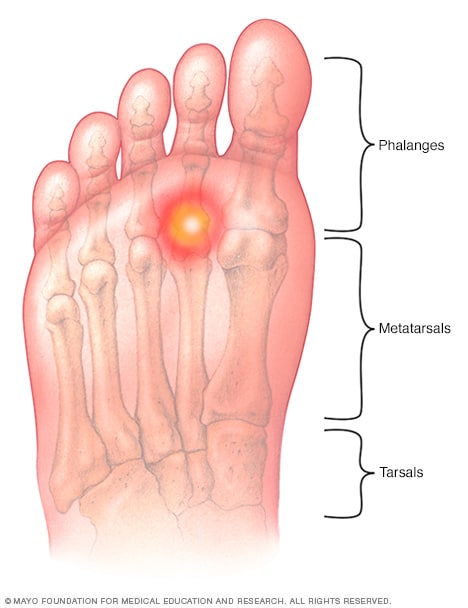Like any other type of pain, a sharp or aching pain in the ball of the foot can be distracting when you walk or run. Unlike stress fractures that often seem to be related to more diffuse pain, Pre-dislocation Syndrome is easier to localize or pinpoint. For example, if you have a bunion, you will know exactly where the pain is (at the big toe joint). If you push on that area when it is inflamed, it will hurt. Similarly, you can have very specific pain at the second toe joint. If you have a sharp pain on the bottom of the second toe joint, you may be suffering from a common condition called “pre-dislocation syndrome.” As the name suggests, the condition is a syndrome that occurs before the toe joint begins to dislocate.
In order for a toe to dislocate, the joint supporting structures must fail. The bones in the toes (phalanges) connect to the bones in the foot (metatarsals) at joints appropriately called the metatarsophalangeal joints. The bones are held together and also allowed to move by a number of soft tissues attachments including the joint capsule (which holds the fluid in the joint to provide lubrication) and ligaments (that keep the joint stable). The toes mostly move up and don’t usually move very far down. As a result, the structures on the bottom of the metatarsophalangeal joints are more prone to stress, strain, and injury. The most significant structure on the bottom these joints, is a thick reinforcing area called the plantar plate. Whenever you move (or force) the toes upward (such as when you stand up on your toes) the plantar plate resists this movement. Stress fractures result from increasing the duration of impact faster than the bones can develop the strength to withstand the impact. In a similar way, the soft tissues that support the bones can also become injured. For example, if a runner is concerned about the impact of running and starts cross training excessively, injury can result. Elliptical trainers and stair-climbers are common culprits. The best feature of an elliptical trainer is that it is very low impact. The worst part is that with every swing of the trainer, the athlete’s foot is dealt an unnatural position that puts a great deal of pressure on the ball of the foot as the foot swings backward. With all of the repeated forcing of the foot up on the toes, the plantar plate on the bottom of the foot can become stressed to the point that it starts to develop little tears. If not rested and allowed to heal these can get worse.
What Causes Pre-Dislocation Syndrome?
An increase in activity that puts stress on the plantar plate (at the bottom of the joint where the second toe connects to the foot) is usually responsible. Once the cycle of inflammation starts, the joint supporting structures become weaker. If the activity and inflammation continue, it can lead to the tearing of the plantar plate, pain in the ball of the foot and even a dislocated hammertoe. Other risk factors include rheumatoid arthritis, oral steroids (like prednisone) and steroid injections.
How Do I Know if have Pre-dislocation Syndrome?
You may have Pre-dislocation Syndrome if:
- Your foot pain is in the ball of the foot
- Pain is worse when you stand on your toes
- Pain is worse barefoot, and walking on hard surfaces
- No history of trauma or injury
- Increased activity (running, stair climbing, elliptical trainer)
- Tenderness if you pull the second toe up away from the ground
- The second toe is lifting off the ground when you stand
- You feel a “fullness” in the ball of the foot.
- Second toe has started to deviate right or left
Your doctor visit will begin with the doctor taking a compete medical history to make sure he has the full story. A physical exam will be performed to make sure that there is no risk for other similar common conditions (such as neuroma, stress fracture or neuropathy). An X-ray exam will also be performed to further evaluate the ball of the foot. Depending upon what shows up on the X Ray, an advanced imaging exam such as MRI, CT scan, or Ultrasound might be needed to get more detail of the injured area. MRI shows inflammation and tears in the joint supporting structures much better than an X-Ray. As an alternative, an arthrogram can be performed. An arthrogram involves injecting a small amount of dye into the joint and then taking an x-ray. If the plantar plate is torn, the dye will leak out of the joint. Treatment of Pre-dislocation Syndrome The good news about pre-dislocation syndrome is that it can often be treated quickly and without surgery. Although crutches, fracture walking boots and below-the-knee casts can help speed healing, these are not always needed. The treatments for pre-dislocation syndrome typically target the inflammation and reduce the stress on the plantar plate. Taping and splinting the toe to reduce the stress on the joint is critical. Your foot doctor will do this for you. Icing, padding and offloading the area (to decrease pressure to the injured area) are other initial treatments used in most cases. Sometimes immobilization in a fracture walking boot is needed to allow the plantar plate to heal. Occasionally crutches are needed. In some cases it may be necessary to stop the activity that is causing the problem.

